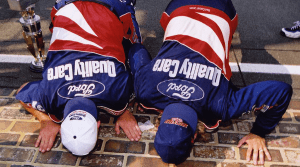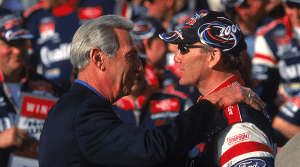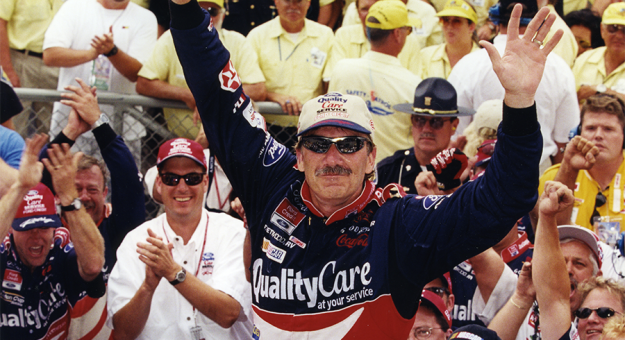Editor’s Note: This is the third of a four-part series on NASCAR Hall of Famer Dale Jarrett. Click here to read part one and two.
With his departure from Joe Gibbs Racing, Dale Jarrett joined Robert Yates Racing in 1995 to pilot the No. 28 Ford in place of injured Ernie Irvan.
Heading into his substitute role, Jarrett made the most of his opportunities, knowing a full time ride wasn’t guaranteed at the conclusion of the season.
A victory at Pennsylvania’s Pocono Raceway, along with 14 top-10 finishes with legendary crew chief Larry McReynolds at the helm helped boost Jarrett’s stock ahead of the 1996 season.
“I knew it was a one-year deal, and the opportunity that were many other opportunities past that which would have still been associated with Robert,” Jarrett told SPEED SPORT. “Then, when he decided on the second car in 1996 where we built the championship team with the 88 car, was just amazing.”
Robert Yates Racing expanded in 1996 with Irvan back in the No. 28 and Jarrett wheeling the No. 88.
The expansion came despite team owner Robert Yates’ initial hesitancy to add a second team. Yates didn’t want to spread the organization thin.
“To have that chance to know that he was taking that chance of doing something he’d really been against, which was making the team bigger, because he just felt like that it might be more stressful on everybody,” Jarrett said. “He didn’t want to outgrow his means there because he wanted to be able to focus on making the one car, the 28 car, which he had so much success with.

“He wanted to keep that focus there to where it could be as good as it possibly could. But then to understand through Ford Motor Co. and sponsors that having two, that we could have more people and better resources and making all of that work.”
Among the many hires for Jarrett’s fresh No. 88 team, was crew chief Todd Parrott.
The duo immediately saw results at Daytona (Fla.) Int’l Speedway in 1996.
“Our very first race together was the Busch Clash in 1996,” Jarrett said. “We won that and turned around a week later and won the Daytona 500. So it was off and running. What transpired over the next 9-10 years, was just an amazing life experience as a competitor and being able to know that every time that you went to the race track, you had an opportunity to run up front, and more times than not, you were going to have a car that was very capable of winning.
“You had to do things differently, because this was more horsepower than I’d ever driven. It was more than most people ever get the opportunity to drive. You had to change driving styles at certain race tracks. Obviously it was a huge advantage to have that at certain tracks.
“It did take a mindset of being willing to change things from what you knew before. To have people like Todd Parrott, Robert and Doug Yates to talk to about that was invaluable to me because I tried to be a sponge and take all of that information in, and then transfer that to how I drove and the decisions I made on the race track.”
A winning mindset became the standard for the No. 88 team. From 1996 through ’98, Jarrett and company never finished worse than third in the standings. However, a championship had yet to be earned.
The introduction of the Ford Taurus after years of competing with the Ford Thunderbird gave teams a hurdle to maneuver around. Still, everything came together in 1999 for the No. 88 group.
“In 1998, even though we still finished third in the points, it wasn’t our best year,” Jarrett said. ‘We struggled at times and at places that we normally didn’t struggle, it became a real struggle. But that made us stronger, and to figure out things with this new car that we needed to know.”
While the season began with a crash at Daytona, Jarrett and the team were primed for a stout campaign.
“From that point forward, it was like every single race that we were either in contention, or even the days that we maybe missed the setup, we took days that we literally were running 25th and made a top five out of it,” Jarrett said.

A sign of the team’s resiliency came in the Coca-Cola 600 at Charlotte (N.C.) Motor Speedway, where Jarrett and the No. 88 team overcame being down a lap to finish fifth. The never-quit mindset caught the attention of Dale Earnhardt, who had wise words for Jarrett during the team’s magical run.
“I’ll never forget a conversation with Dale Earnhardt during that year that he said, ‘Look, when you go on and win this championship, you’re gonna remember those days that you made something out of nothing more than you’re going to remember what races you win in that year.’
“That’s really the truth, because I’m pretty sure we won at Michigan and I think I won at Richmond, whenever the first race there that we took the lead in the points. I don’t think we ever gave it up after that. From that, I don’t know the other two races that we won.”
The other two victories came at Daytona and Indianapolis. After it was all said and done, Jarrett ended the season with 29 top-10 finishes in 34 races, along with an average finish of 6.8.
While Jarrett and the No. 88 team only hoisted the championship trophy once, their success continued through 2003.
Among the preceding highlights in the blue-and-red No. 88, came one final Daytona 500 triumph in 2000, after a dominant performance which saw Jarrett clamp down the field from the pole.
With changes on the horizon in the coming years, one more shot of glory came for Jarrett before the next phase of his career approached.
Find out in part four — tomorrow.
Follow @DHoffmanMedia22